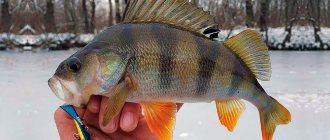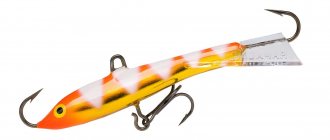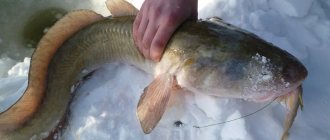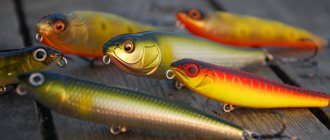Perch bite throughout the winter, and since they are the most popular fish for ice fishing, there are so many bait options to target them. Standard jigs, spinners and balancers are not enough for everyone. The more different baits you have on hand, the greater the chances of a good catch. You should definitely add devils to your arsenal. These original reelless baits are great for attracting perch.
What is this devil?
In its external shape, this bait somewhat closely resembles a droplet, from the body of which a triple hook emerges. On the top of this bait there is a special kind of ear where the fishing line is threaded. The hooks of such bait have beads or cambrics, which, when fishermen are retrieving, actively move along the hook, thereby effectively luring winter perch. But it happens that the most effective bait for perch may not work in a given situation, it’s worth replacing it and trying to catch perch in winter using a goat
At its core, the devil is a nozzle-type jig; such jigs for perch are distinguished by the fact that they have their own strict centering relative to the vertical axis. When fishing for winter perch with such baitless bait, an important factor will be monotony and the complete absence of any failures in the wiring.
Advantages of the “devil”
Fishing with the “devil” is a gamble, obviously doomed to success, regardless of the experience of the fisherman and the performance of the bait. The main thing is that there is fish under the hole; learning to fish with this jig is not easy, but very simple. And that's why:
- The classic “devil” is symmetrical and balanced, so it cannot resonate. The only thing he is capable of is shaking in a vertical plane. Therefore, there is no “ballet” over the hole like “files”, “herringbones”, “ladders” [1]
This refers to techniques for playing with no-attachment jigs. won't be needed here. All the fisherman needs to do is move the fishing rod smoothly, pause, and carefully follow the nod. - The presence of hooks sticking out in all directions significantly reduces the chance of an empty hook. No matter where the fish comes to the jig from - from the rear or from the flank - a sharply sharpened sting awaits it everywhere. The chances of escaping are so small that they tend to zero.
- The appearance of the “devil” is very reminiscent of the same invertebrate mentioned above, which is the primary food of the fry. It is clear that when a fish grows up, it stops eating these small fry, but the memory of delicious food remains with it. How else can we explain the fact that the “devil” is often grabbed “on the hook” - as if in fits of some kind of “nostalgia”.
Photo 2. The Cyclops crustacean is the natural prototype of the “devil” jig.
No matter how many times I was fishing, I observed the first attempts to catch “with the devil” - every time I saw the same result: after some short time after sending the jig to the bottom of the reservoir (which, apparently, the fisherman needed to “fill his hand”) - a variety of fish began to be dragged out representatives of the ichthyofauna onto the ice according to the “one after another” system, which continued until there were no more fish in a certain radius from the hole. The fisherman changed the hole to an unfished one - everything was repeated. Having tried it myself, I not only confirmed the trend, but also forever fell in love with this method of fishing. Fishing “on the devil” is a one-way trip.
It is not without reason that seasoned baitless fishermen have recently increasingly recommended that beginners begin the thorny path of reelless fishing with the “devil” - as the easiest option to master.
However, even if the “devil” does not require the fisherman to master the “balalaika”, he really needs fine-tuning of the gear.
What are the features of catching winter perch using a devil?
Many anglers note the high degree of efficiency and catchability of the devil for winter perch. Fishing devils for perch are most effective during the deep winter, when perches are least active, and it is devils that can stir up the striped robber. At the same time, the fishing process of catching winter perch with devils will require great perseverance from fishermen.
Closer to the beginning of spring, when the perches become more mobile, you should attach a burdock larva to each hook to make fishing more effective. Closer to the spawning period, catching perch becomes more effective with the help of small-sized devils.
Tackle for catching winter perch with a devil
When catching winter perch using a devil, fishermen can use all kinds of winter fishing rods - fillies, balalaikas, reelless rods and many others. The fishing rod should be distinguished by its light weight. At the same time, the process of setting up the rod is much more important. For each devil bait, depending on the weight parameters, it is necessary to configure the rod. Therefore, it is better to pre-set several fishing rods for each type of devil.
To catch perch in winter using a devil, you should take a thin, but very strong type of fishing line, approximately in the area of about 0.1-0.12 millimeters. When using thick lines when fishing with devils, the game with this bait will be disrupted.
The process of attaching the devil itself to the fishing line will directly depend on the design of the devil. The most common types of devil have a ring or eyelet for attaching to a fishing line. Here, the best fastening option would be types of fastening such as clinch, palomar, loop through a figure eight or Rapala knot. At the same time, there are devils with a hole through the body of the devil itself.
It is also important to choose the right nod for a winter fishing rod; for this, anglers most often use guards made of a material such as lavsan or metal. Nods of the curved type or nods in the shape of the letter S can be used. Moreover, the fact that the angler has assembled all the equipment correctly or incorrectly can only be understood after several fishing trips for the devil.
How to make a devil with your own hands
Making a catchy devil
As a rule, every angler has such a jig as the “devil”. Some buy them, and some make them with their own hands, especially since it is not at all difficult. In addition, at home you can make several of them, differing in shape, weight and size. If you buy them (more than one), it will result in a good amount. Moreover, not all purchased jigs have an action that may interest perch or other fish.
There are several ways to easily and quickly make bait at home. “Devil” is made from different metals, but tin, solder or lead are more suitable for home production, since they melt at lower temperatures. Therefore, they can be used to cast bait of any shape or size.
Several methods have been invented for making the “devil”. Some specialists first prepare several forms, after which they are immediately filled and receive several baits at the same time. Some anglers use solder and solder all the parts together, after which they are processed to get the desired shape and ground. Some fishermen simply fasten two shanks of hooks together and wind wire on top. The result is a very interesting “devil”. When making it, it is very important that imagination is present, then you can make a bait of any shape.
What is needed for this?
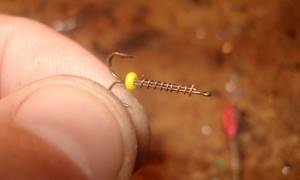
To make a “devil” type jig, you will need the following materials and tools:
- A little tin or lead.
- Required number of hooks.
- Beads.
- Copper wire.
- A block of wood.
- Cold welding.
- Needle files.
- Soldering iron.
- Foil.
Manufacturing instructions
Making a jig - devil in 5 minutes.
The manufacturing method is quite simple, but requires some caution. Safety should always come first. So:
- Hooks with a long shank are used. This way it’s more convenient to make a threesome out of them. Hooks number 3 will do. The ears of two of them are bitten off and the soldering areas are cleaned.
- Three cuts are made on a piece of wood, up to 3 mm deep and located at an angle of 120 degrees.
- Hooks are inserted into these slits so that they point up with the shank.
- A thin wire is taken, after which they are firmly connected to each other at the soldering point.
- A kind of funnel is formed from the foil and placed on the hooks so that the cone is located on top of the forend.
- Molten lead or tin is poured into the middle of the funnel. The funnel is filled completely and accurately.
- Before pouring, you need to insert a ring for fastening into the middle of the mold.
- After the metal has cooled down, it is removed from the mold and processed to give the workpiece the desired size and shape.
- For greater attractiveness, the “devil” can be painted in a bright color.
Varieties of perch devil
In addition to the classic devils, other variants of fishing devils are also used for catching winter perch. If the classic version of the devil for perch has a soldered treble hook, which is sealed into the base of the drop, then there are varieties of fishing devils for winter perch, which differ in that their tees are attached freely.

There is a version of the devil, when a triple-type hook is attached to a loop at the bottom of the devil itself. A variant of the fishing devil is also possible, when three tee hooks are attached to a special ring that encircles the entire body of the devil along the top, and many fishermen consider this version of the devil to be the most effective for winter perch.
The most popular among anglers when fishing for winter perch are short-bellied devils; many anglers note the fact that it is these devils that best lure winter perch, and the angler will never go home without a catch. The most common color of devilfish for winter perch is black or dark green. The most popular materials are those made of lead, although there are options made of tungsten, tin or plastic.
Nod selection
The main component of winter gear for catching devils is the nod. Experienced craftsmen prefer long products measuring 165.5–235.5 millimeters, which allows them to achieve a relatively low frequency (about two vibrations per second), as well as a large amplitude of vibration of the edge of the nod. The use of long nods ensures stable play of the bait regardless of the position of the hand, from the beginning of the retrieve to the end.
In this case, the swing of the nod is adjusted taking into account fishing conditions. For example, if there is a strong wind outside, and fishing takes place at great depths or strong currents, then it makes sense to shorten this element by 95-135 millimeters. If fishing takes place in a shallow area, then vice versa - it is extended to its maximum length in order to achieve a smooth, measured game. Otherwise, the friction of the fishing line against the water column in shallow water will lead to various non-harmonic vibrations of the fishing rod , which will negatively affect the performance of the bait.
Using a long nod with good rigidity allows you to dampen unexpected vibrations and possible shocks when there is a gust of wind. In addition, if you accidentally hit your clothing with the fishing rod, this will not affect the nature of the “devil’s” movement in any way. In essence, the nod is a continuation of the whip, which arches above its contour in a free state. At the same time, under the load of the “devil,” it bends plastically at a small angle. When fishing, the product is bent in the opposite direction, pinching its first third from the end with the thumb and forefinger.
When choosing a nod, you need to pay attention to its end ring. For most conditions, a ring with a diameter of 1.8-2.35 millimeters is suitable, which will easily pass the fishing line. You can make this part yourself using nichrome wire with a thickness of 0.21-0.35 mm. To make a nod, it is customary to use lavsan or propylene tape with a cross-section of 3-4.5 mm.
Technique for catching winter perch using devil bait
Experienced fishermen, who have been using devilfish for catching winter perch for a long time, say that such fishing involves constant experimentation with fishing methods. At the same time, sometimes passive wiring methods are effective and sometimes very active ones. Over the years, each angler develops his own methods of guiding with the help of a devil, which are the most effective.
To effectively lure perch from the nearest water area of the reservoir around the hole, lower the devil to the surface of the bottom of the reservoir, while tapping the bait on the bottom a couple of times to raise a little mud, and then toss the devil five to seven times and release it to the bottom again, the height of the devil's rise approximately seven to ten centimeters.
Next, we carry out the process of stepwise dotted ascent of the devil, approximately similar to the movements of amphipod crustaceans. In this case, after ten to fifteen centimeters, short pauses should be made, and during such a pause a bite can easily occur.
To provoke a perch, which can position itself not far from the devil and simply watch it without daring to attack, you should slightly change the pace or change the size parameters of the devil used. Tap the bottom more often to raise more turbidity.
When fishing for active winter perch, chaotic and fast movements work better. During periods when the perch is passive, you should use more movements of the devil of a slower and smoother nature.
Specifics of fishing for perch in the dead of winter
In the dead of winter, even large perch, which are not used to leaving their favorite snags even in cold weather, can leave their homes and go to “warm regions,” that is, closer to the warm bottom.
There he burrows into or remains at peace. It will be extremely difficult to attract attention during this period of time, even using a simple devil. Any attempts will end with the catch of smaller individuals.
In other words, in the dead of winter, if you cannot catch a humpbacked predator in shallow water (1.5 - 3 meters), in its favorite places, in creeks with a rocky, snagged bottom, in reeds, then hope to catch it in places where the depth is greater - the matter is doubtful.
However, you can try. To do this, it would not be amiss to make several holes in the ice and periodically walk between them - suddenly you will be lucky and the attention of the humpback whale will be disturbed by a small and harmful object constantly looming in front of its nose, which does not give the old perch any rest.
In this case, in a fit of anger, he will sharply rush to the surface, grab the bait and become the long-awaited prey for the frozen and tired, happy fisherman who has lost all hope!



